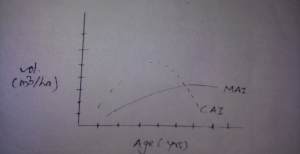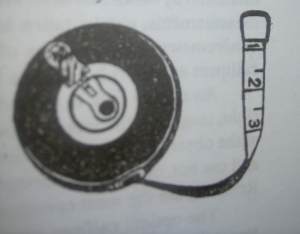The age of trees is either determined by their general appearance or from existing record. The size and taper in stem, size and shape of the crown, and the color and condition of the bark. But this method requires a great practice and experience and to estimate the age of tree within responsible limits of accuracy.
Some trees shows distinct annual rings on their cross section. So the age of the trees when standing can be determined by pressler’s borer. This instrument is used to take out a narrow cylinder of the about 2cm in length from a standing tree at both ends of the diameter. The number of the rings on the cylinders are counted. Then by ratio proportion method, the number of rings on the whole diameter are estimated.
Age of the trees which do not show annual rings is determined by measuring of trees of various sizes at fixed intervals. The measurement of a particular year are then classified by diameter classes and the average diameter of each diameter class is found. The same procedure is followed at subsequent measurements taken after a fixed interval. The difference between the two averages gives the periodic diameter increment which is then plotted against DBH and a smooth curve drawn. The increment curve is transformed into diameter age curve. From this curve, age of any tree of known DBH can be read.
The age of felled tree can be determined if the stump shows the annual rings. The rings are counted after levelling the stump by a chisel along the diameter on which the rings are to be counted. Then age to stump height is added to determine the age of the tree at the time it was felled.
The age of trees is either determined by their general appearance or from existing record. The size and taper in stem, size and shape of the crown, and the colour and condition of the bark. But this method requires a great practice and experience and to estimate the age of tree within responsible limits of accuracy.
Some trees shows distinct annual rings on their cross section. So the age of the trees when standing can be determined by pressler’s borer. This instrument is used to take out a narrow cylinder of the about 2cm in length from a standing tree at both ends of the diameter. The number of the rings on the cylinders are counted. Then by ratio proportion method, the number of rings on the whole diameter are estimated.
Age of the trees which do not show annual rings is determined by measuring of trees of various sizes at fixed intervals. The measurement of a particular year are then classified by diameter classes and the average diameter of each diameter class is found. The same procedure is followed at subsequent measurements taken after a fixed interval. The difference between the two averages gives the periodic diameter increment which is then plotted against DBH and a smooth curve drawn. The increment curve is transformed into diameter age curve. From this curve, age of any tree of known DBH can be read.
The age of felled tree can be determined if the stump shows the annual rings. The rings are counted after leveling the stump by a chisel along the diameter on which the rings are to be counted. Then age to stump height is added to determine the age of the tree at the time it was felled.




